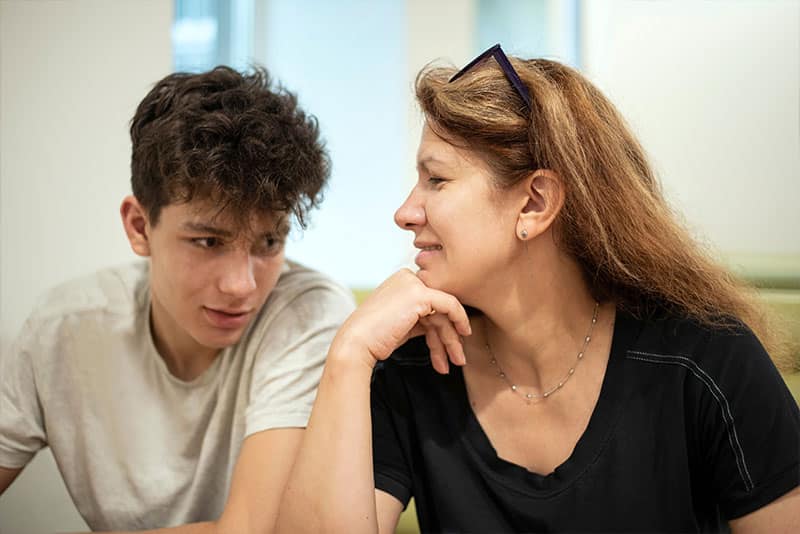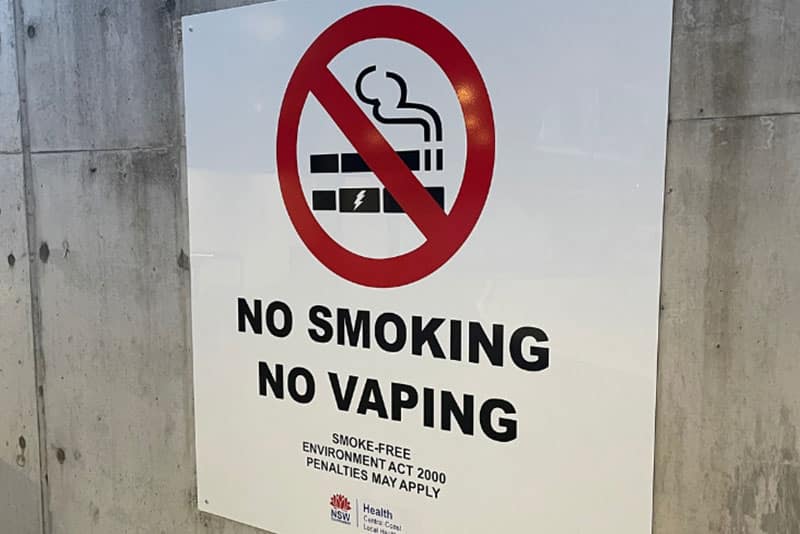Vaping
Vapes contain or produce harmful chemicals known to cause serious lung damage and cancer. The nicotine found in them is highly addictive and can affect brain development in young people.
This page will help you know the risks, spot the signs of nicotine addiction, report illegal supply of vapes, as well as access advice and resources that will help you support loved ones to stop vaping.

What are vapes?
Vapes are battery-powered devices that heat a liquid until it produces an aerosol. The user then inhales the aerosol.
This aerosol contains a toxic mix of harmful chemicals also found in cleaning products, nail polish remover, weed killer and bug spray. It also contains heavy metals shed from the heating coil inside the device. These harmful substances are present in all vapes, not just those that contain nicotine.
Vapes are also called e-cigarettes, pods or sometimes by their specific product name, such as a STIG, Cuvie or Juul. They come in many shapes and sizes and can be made to look like everyday items like highlighters, pens or USB memory sticks.
While most people do not vape, their use is increasing,[1] particularly amongst children and young adults. This is largely due to increased access from shops who are illegally selling them. It is also a result of predatory marketing from the tobacco industry, who are targeting young people in order to make a profit, despite knowing the harms of vapes and how addictive they can be.
Together, we can take action to protect our local communities and future generations from the harms of vaping and smoking so that they can live longer, happier and healthier lives.

What you and our community can do
Here are some things we can all do to prevent more children and young people taking up vaping or smoking and help those becoming addicted to nicotine.

There are many risks from vaping, regardless of whether the device contains nicotine or not.
The aerosol you inhale contains toxic chemicals such as formaldehyde, acetaldehyde and acrolein and heavy metals like nickel, lead, tin and aluminium that cause DNA damage, serious lung damage and cancer.[2]
What’s more, vaping can cause physical harm too; there are now thousands of cases of people being injured by faulty batteries in vapes exploding.
Vapes containing nicotine are highly addictive, while even non-nicotine vapes can create a dependence. So, even when you want to stop inhaling harmful chemicals into your lungs over and over, it becomes hard to stop.
Nicotine exposure during childhood and adolescence affects brain development and impacts the parts controlling learning and attention. In addition, inhaling too much nicotine can cause nausea, vomiting, chest pain, headaches, dizziness and seizures. Nicotine is also a poison and can make someone very ill or even be fatal if they swallow it, spill it on their skin or get it in their eyes.
Most vapes labelled as ‘nicotine free’ have been found to contain nicotine when tested, so people can think – wrongly – that they are using non-nicotine devices with no risk of addiction. In any case, all vapes are harmful to you.
Useful resources on vaping
- NSW Health’s ‘Every vape is a hit to your health’ campaign encourages young people to consider the proven health harms of vaping, such as nicotine addiction, lung damage, breathlessness, nicotine poisoning and burns from exploding vapes. The campaign has been developed by the Cancer Institute NSW in consultation with young people and medical experts, and features testimonial videos from young people who have experienced the health harms of vaping.
- NSW Health’s ‘Do you know what you’re vaping’ campaign has factsheets for teens, parents and carers, teachers and health professionals.
- Quit’s resources for parents, carers, teachers and teens, including factsheets, videos and social media tiles.
- Central Coast Health Promotion Service’s own ‘Say No to Vaping’ campaign has posters, social media tiles and animations, FAQs and more to support teachers and organisations that work with young people.
- Lung Foundation Australia’s factsheets for parents, carers and young people.
- Watch our ‘Understanding the health risks of e-cigarettes and vaping’ video with Dr Lyndon Bauer, a GP on the Central Coast, below.

Testing has shown many vapes labelled ‘nicotine free’, in fact, contain high levels of nicotine. People thinking they are using nicotine-free vapes can unknowingly quickly develop a nicotine addiction. The nicotine in one vape can equal up to 50 cigarettes.
Nicotine addiction and withdrawal from vaping is the same as for people who smoke cigarettes. A person trying to quit nicotine usually experiences:
- cravings
- irritability
- anxiety and depression
- poor attention and memory
- difficulty sleeping
Vaping nicotine also means you are three times as likely to start smoking cigarettes.[3]
Nicotine e-liquid can poison somebody quickly if they swallow it, spill it on their skin or get it in their eyes. It can make someone very ill and, in some cases, can even be fatal. Young children are at highest risk.
Typical symptoms of nicotine poisoning are:
- burning of the mouth and throat
- nausea and watering mouth, vomiting, pain in the stomach or gut, or diarrhoea
- dizziness, faintness or weakness
- high blood pressure followed by low blood pressure
- mental confusion
- headache or hearing and sight disturbances
- finding it hard to breathe or stand
- convulsions or sweating
- rapid or erratic heart beats
If a child has swallowed any vaping liquid at all, call 000 or the Poisons Information Centre immediately on 13 11 26, 24 hours a day, seven days a week. If an adult has swallowed vaping liquid and feels ill, call the Poisons Information Centre or seek medical attention.
Find out more:

The aerosol from vapes contains many harmful substances when inhaled by users and bystanders. That is why e-cigarette use is included in smoke-free legislation in NSW, and indeed all states and territories across Australia. Where one cannot smoke, one cannot vape.
In addition, in NSW, it is illegal:
- to sell tobacco, non-tobacco smoking products, e-cigarettes (whether they contain nicotine or not) or e-cigarette accessories to a person under the age of 18
- to display, advertise or promote e-cigarettes
- for retailers (other than pharmacies) to sell e-cigarettes or e-liquids that contain nicotine, including online sales, to all ages
- to possess liquid nicotine, whether it is in a bottle or an e-cigarette, illegal unless the possessor has a valid prescription.
Authorised inspectors in Public Health Units across NSW:
- conduct regular controlled purchase operations to monitor retailer compliance with sales to minors; and
- respond to reports made by the community of suspected breaches of the laws.
You can report a breach of these laws online, or by calling the Tobacco Information Line on 1800 357 412 or your local Public Health Unit. If you suspect a store or person (other than a pharmacy), selling vapes containing nicotine, contact Crimestoppers.
Find out more about the laws and retailers’ responsibilities:

Have a conversation about vaping
The following links provide some tips on how to talk to young people about vaping.
- Talking about vaping with young people – Alcohol and Drug Foundation
- Vaping and Young People For Parents Factsheet – Lung Foundation Australia
Vaping curriculum resources for teachers
A number of curriculum-based resources have been developed to support teachers in delivering education about the dangers of using vapes.
- A new PDHPE syllabus for stages 4 and 5 (years 7–8 and 9–10), has been developed by the Department of Education, NSW Health and NSW Cancer Council. Teachers can access this via their online Department of Education portal.
- NSW Health vaping toolkit for schools to increase awareness around the health risks of vaping and address misperceptions about vaping amongst students aged 14–17 years.
- ‘Recognising tobacco industry manipulation’ learning package from Murrumbidgee Local Health District designed for stage 5 outcomes (years 9 and 10). The learning package includes the ‘Know when you’re being played’ video.
- Vaping and young people presentation from Illawarra Shoalhaven Local Health District aimed at teachers and school support staff, as well as youth and health workers who would like to know more about the issue of vaping and young people. The presentation covers the situation as of June 2022, focusing on the disposable vapes, NSW and Australian law on e-cigarette sales and use, what are the potential health risks, tips for responding to young people and accessing further support.
- The Science of Vaping – Behind the News webpage (abc.net.au) features a video report highlighting what’s in a vape and links to a number of year 9 and 10 curriculum resources with activities to engage and educate students on healthy choices.
Quit vaping support training for clinicians and other professionals working with young people
The following can support professionals working with young people, such as GPs, nurses, pharmacists, school support officers, counsellors, youth workers and teachers.
- Guide to Support Young People to Quit E-Cigarettes – NSW Health
- Vaping in Youth Pathway – HealthPathways Central Coast (login required)
- Clinician’s Guide to Supporting Adolescents and Young Adults Quit Vapes – Sydney Children’s Hospitals Network
- KidsQuit: Brief Interventions in Smoking Cessation e-learning – Kids Health (contains section on vaping)

Quitline is a free clinical program that provides confidential advice, tips, and support to help people quit vaping or smoking. Counsellors will also help you think of ways to approach a conversation with someone you know who needs support to kick the habit.
Adults can also call the Quitline program for advice on how to support a child or young person. You can request a call back or call Quitline program on 13 7848. A culturally sensitive service is available for Aboriginal and Torres Strait Islander people by calling 13 7848 and asking to speak to an Aboriginal counsellor.
You can also talk to your GP about a quit plan.
Some people may find issues relating to vaping or smoking distressing. If you or someone you know needs additional support, please contact any of the below crisis support helplines.
Young people
- Pave is a new free evidence-based app developed by Cancer Institute NSW together with young people to help them quit vaping. It provides tips, motivation, tracking tools, distractions for when cravings hit, as well as activities and information to navigate common barriers to quitting vaping. It also provides daily check-in feature supporting users to reflect on their progress and a click-to-call function to connect with Quitline counsellors.
- Headspace can help young people (aged 12–25) with mental health, alcohol and other drug services, and work and study support. Visit headspace.org.au.
- Kids Helpline provides free, 24/7 advice and counselling on the phone, through Webchat or online. Call 1800 55 1800 or visit kidshelpline.com.au.
- Youth Beyond Blue helps young people to understand and look after their mental health. Young people can call or chat online with a counsellor at any time. Call 1300 22 4636 or visit www.youthbeyondblue.com.
- Child and Adolescent Mental Health Services provide specialist community-based services for young people. Call the NSW Mental Health Line on 1800 011 511 for advice, assessment and referral.
Adults
- Lifeline: 13 11 14
- Suicide Call Back Service: 1300 659 467
- Beyond Blue: 1800 512 348
- MensLine Australia: 1300 789 978

We encourage promotion of the risks associated with smoking and vaping at any time. However, World No Tobacco Day is held on 31st May every year, providing a timely opportunity to raise public awareness about how the tobacco industry works to manipulate youth and the health risks associated with smoking and vaping. A number of organisations will produce materials to help promote World No Tobacco Day messages, while you may also wish to use general resources highlighted on this page to help promote the facts about smoking and vaping.
[2] National Health and Medical Research Council (2022) Inhalation toxicity of non-nicotine e-cigarette constituents: risk assessments, scoping review and evidence map
[3] Baenziger ON, Ford L, Yazidjoglou A, Joshy G, Banks E (2021) E-cigarette use and combustible tobacco cigarette smoking uptake among non-smokers, including relapse in former smokers: umbrella review, systematic review and meta-analysis. BMJ Open

State and territory initiatives
The Government will also work with states and territories to close down the sale of vapes in retail settings, ending vape sales in convenience stores and other retail settings, while also making it easier to get a prescription for legitimate therapeutic use.
The new National Tobacco Strategy 2023–2030 commits to reducing daily smoking prevalence to below 10% by 2025 and to 5% or less by 2030 and prioritises tackling smoking in First Nations communities.
Other priorities include:
- Tax on tobacco products will be increased by 5% per year for 3 years in addition to normal indexation.
- A new national lung cancer screening program.
- Tackling Indigenous Smoking program will be extended to reduce both vaping and smoking among First Nations people.
Other pages you might be interested in
Latest News


Advice and support on alcohol and pregnancy



